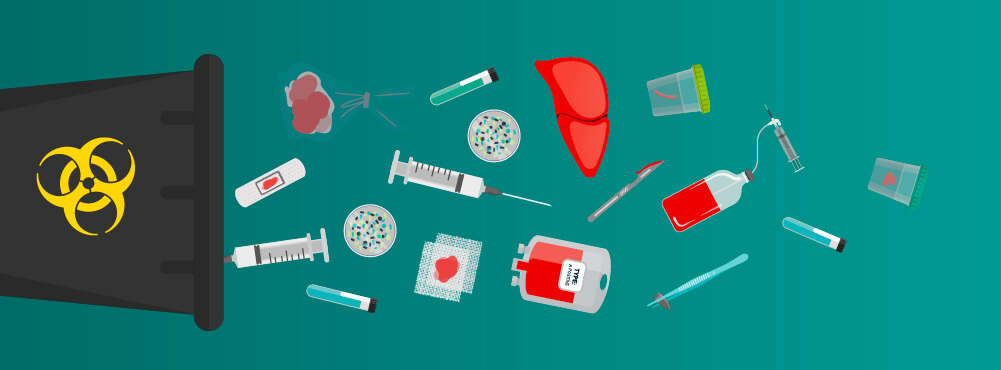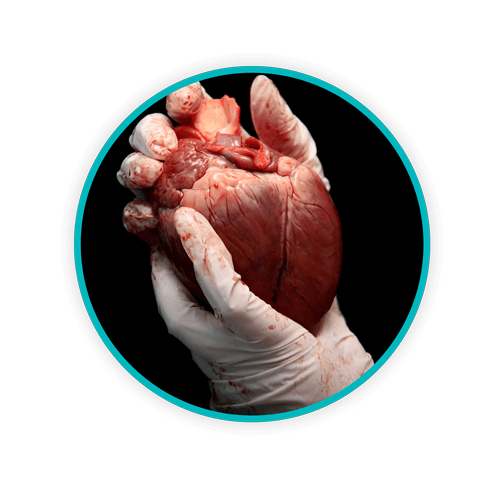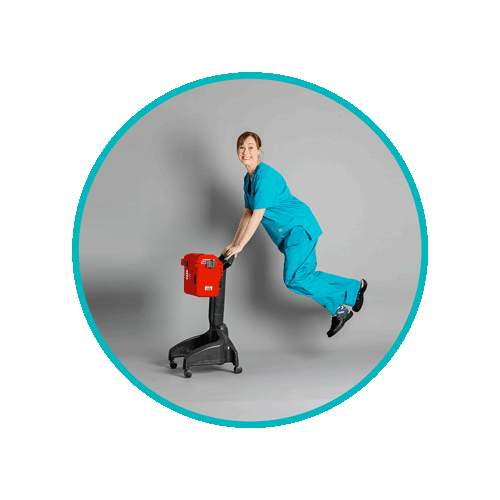What Is Considered Biomedical Waste?

The definition of biomedical waste differs depending on the Canadian province in which your facility is located. Therefore, the rules and regulations your facility must follow when segregating, handling, storing, and disposing of biomedical waste in these different provinces vary, as well. In addition to these rules, counties and municipal governments can have their own set of rules to follow. In many cases these rules are even more strict than federal or provincial rules. Basically, there are many different rules covering healthcare waste disposal and your facility must take care to follow all of them.
TOPICS WE WILL COVER:
1 / What is Biomedical Waste?
2 / How Different Provinces Define Medical Waste
3 / What Canadian Agencies Are in Charge of Biomedical and Biosafety Regulations in Canada?
4 / What Do the Rules in Canada Say about Biomedical Waste Management?
5 / Handling and Storage of Anatomical Waste
6 / Disposal of Anatomical Waste
7 / Daniels Offers Solutions
What Is Biomedical Waste?
For example, the province of British Columbia breaks down biomedical waste into categories. These categories include:
- anatomical solids and liquids waste from humans and animals
- microbiological wastes such as waste serums and vaccines
- non-anatomical wastes such as equipment
- waste sharp items such as hypodermic syringe needles, called “sharps”
- chemical and pharmaceutical wastes
How Different Provinces Define Medical Waste
Canadian provinces can define biomedical waste as they choose or not define it at all. Here is how some of the provinces define biomedical waste.
British Columbia
British Columbia’s definition states the different types of biomedical waste to “include anatomical solid and liquid waste from humans and animals, microbiological wastes such as waste serums and vaccines, non-anatomical wastes such as equipment, waste sharp items such as hypodermic syringe needles, called “sharps,” and chemical and pharmaceutical wastes.”
Alberta
Alberta handles biological waste differently. In Alberta, biomedical waste is not defined, and it is not regulated as hazardous waste. Therefore, generators of biomedical waste in Alberta will need to follow federal regulations.
Saskatchewan
Saskatchewan defines biomedical waste as that part of medical waste that necessitates special precautions including waste that is:
- Cytotoxic
- Infectious
- Sharps
- especially sensitive due to the nature of the waste (i.e., human body parts)
Ontario
Ontario also defines biomedical waste. This waste includes:
- Animal blood waste
- Animal anatomical waste

- Human blood waste
- Human anatomical waste
- Cytotoxic waste
- Microbiology laboratory waste
- Sharps waste
- Waste that has come into contact with human blood waste that is infected or suspected of being infected with any infectious substance (human)
- Waste that is derived from or contains any of the types of waste listed above.
Québec
Québec is another province that has its own definition of biomedical waste. In Québec, it is defined as:
(1) human anatomical waste consisting of body parts or organs, but excluding teeth, hair, nails, blood and biological liquids;
(2) animal anatomical waste consisting of carcasses, body parts, or organs, but excluding teeth, hair, claws, feathers, blood and biological liquids;
(3) non-anatomical waste consisting of any of the following:
- a sharp or breakable object having been in contact with blood or with a biological liquid or tissue and having been used in medical, dental, or veterinary care or in a medical or veterinary biology laboratory, or such an object used in thanatopraxy hereinafter called “sharp medical object”;
- a sharp object that has been in contact with blood or with a biological liquid or tissue from a person or an animal, from household activities or non-medical beauty care, such as an injection, provision of care, tattooing, piercing or electrolysis, hereinafter called “sharp household object”;
- biological tissue, cell culture, microbial culture, or material in contact with such tissue or culture used in a medical or veterinary biology laboratory;
- live vaccine;
- a blood container or material that has been saturated with blood and used in medical care, in a medical biology laboratory, or in thanatopraxy;
(4) biomedical waste from outside Québec, including any of the types of biomedical waste referred to in paragraphs 1 to 3.”
While this is just a sampling of the biomedical waste definitions in the ten Canadian provinces, it illustrates how varied and nuanced rules can be between areas. That’s why it is always essential to make sure you and your employees are familiar with the federal definition and regulations for biomedical waste as well as those specific to your territory or province.
What Canadian Agencies Are in Charge of Biomedical and Biosafety Regulations in Canada?
There are several government agencies in Canada that are responsible for developing biomedical waste management for the entire country. The Government of Canada published the “Canadian Biosafety Standard,” which should be routinely reviewed. Agencies, such as the Canadian Standards Association and the Canadian Council of Ministers, also published guides concerning the handling of this waste, including “Guidelines for the Management of Biomedical Waste in Canada” and “Guidelines and Standards for sharps injury protection and sharps containers,” respectively.
Additionally, you should always familiarise yourself with the guidelines for your province or territory. This is vital since it is possible that these standards could be stricter than the federal guidelines, and if that is the case, they will need to be followed as well.
What Do the Rules in Canada Say about Biomedical Waste Management?
Familiarise yourself with the Canadian Environmental Protection Act (CEPA) online to learn more about the details concerning healthcare waste. This Act regulates different types of waste, including biomedical waste. The CEPA states that its purpose is to “contribute to sustainable development through pollution prevention. It provides the legislative basis for a range of federal environmental and health protection programs.”
You can find more information regarding the packaging and segregating of biomedical wastes, as well as treatment options, if needed, in the Guidelines for the Management of Biomedical Waste in Canada document. The information is applicable to all provinces, and it also contains regulations that you will need to follow when transporting biomedical waste.
For instance, the Environmental Protection Service (EPS) of the Department of Environment and Natural Resources is the Government of the Northwest Territories (GNWT) agency that regulates hazardous waste, including biomedical waste. In Ontario, the Ministry of the Environment and Climate Change is in charge of regulating this waste. All of the different provinces have their own guidelines that need to be followed in addition to the federal guidelines.
Handling and Storage of Anatomical Waste
All workers in healthcare facilities that handle biomedical waste, or any hazardous substances need to know how to handle and prepare this waste for disposal safely. There are several things these employees must take into account when deciding how to accomplish this task. This includes determining what kind of waste they are handling, the correct colour-coding and labelling procedures necessary, transportation rules, disposal regulations, and local regulatory requirements.
Your facility will also need to comply with all regulations, both federal and provincial, for storing biomedical waste after you have it picked up and transported. Additionally, before you have biomedical waste transported, it must be stored in a place that is separate from any food preparation areas and is enclosed so as not to be accessible by unauthorized personnel.
You must also be sure to label and identify any biomedical waste storage areas with biohazard symbols. Federal guidelines give detailed instructions concerning the storage area’s temperature. As an example, you must refrigerate biomedical waste at a temperature of four degrees Celsius or, if stored for over four days, a lower temperature. You can find more information concerning time and temperature rules, which vary by province and territory, from your provincial and territorial authorities.
Disposal of Anatomical Waste
If your facility generates biomedical waste, it is important to remember that the different provinces will have their own regulations regarding the disposal of medical waste. For example, Saskatchewan recommends segregating biomedical waste into several different classes in order to make the disposal more cost-effective. These include:
- Animal Biomedical Wastes
- Cytotoxic Chemical Wastes
- Human Anatomical Wastes
- Human Blood and Body Fluids Wastes
- Microbiology Laboratory Wastes
- Sharps Wastes
- Special Precaution Wastes
Make sure your facility reviews the rules and regulations of the federal government, as well as those of the province or territory in which it is located. Read and review the rules of the federal and provincial or Territory government to ensure compliance at all times.
Daniels Offers Solutions
Daniels Health offers educational resources for medical teams to stay familiar and compliant with local, provincial, and national regulations for biomedical waste. Partnering with waste management experts makes avoiding fines, ensuring staff safety, and properly handling biomedical waste far easier than doing it alone. Working with Daniels offers unmatched convenience for disposing of the hazardous wastes medical facilities generate. Have a question? Reach out to a Daniels expert today.
1 https://www.canada.ca/en/public-health/services/canadian-biosafety-standards-guidelines/handbook-second-edition/chapter-16-20.html
Let's Talk!
Your time is valuable, and we don’t want to play hard to get. You can either phone us directly on the details listed on our contact page, or feel free to fill out this short form and one of our team members will get back to you as quickly as possible.
